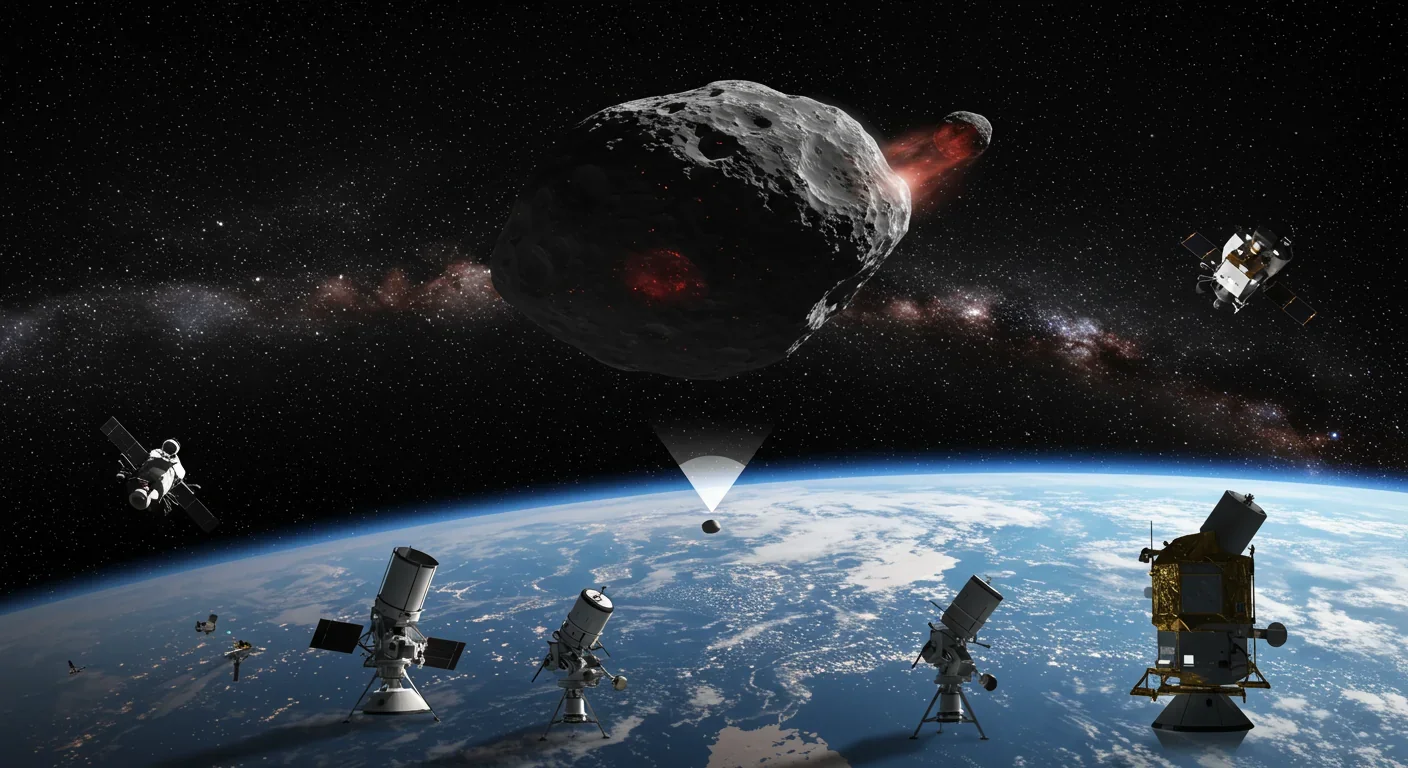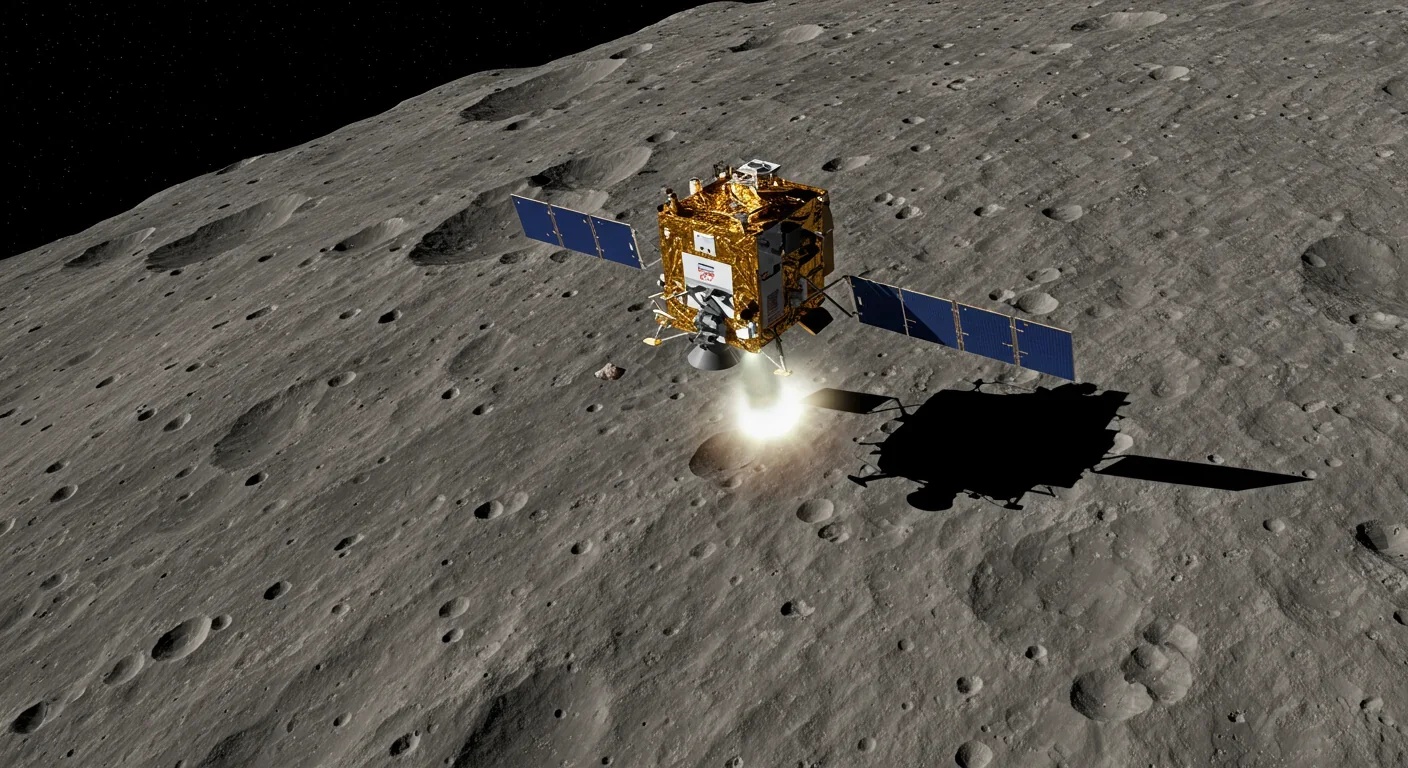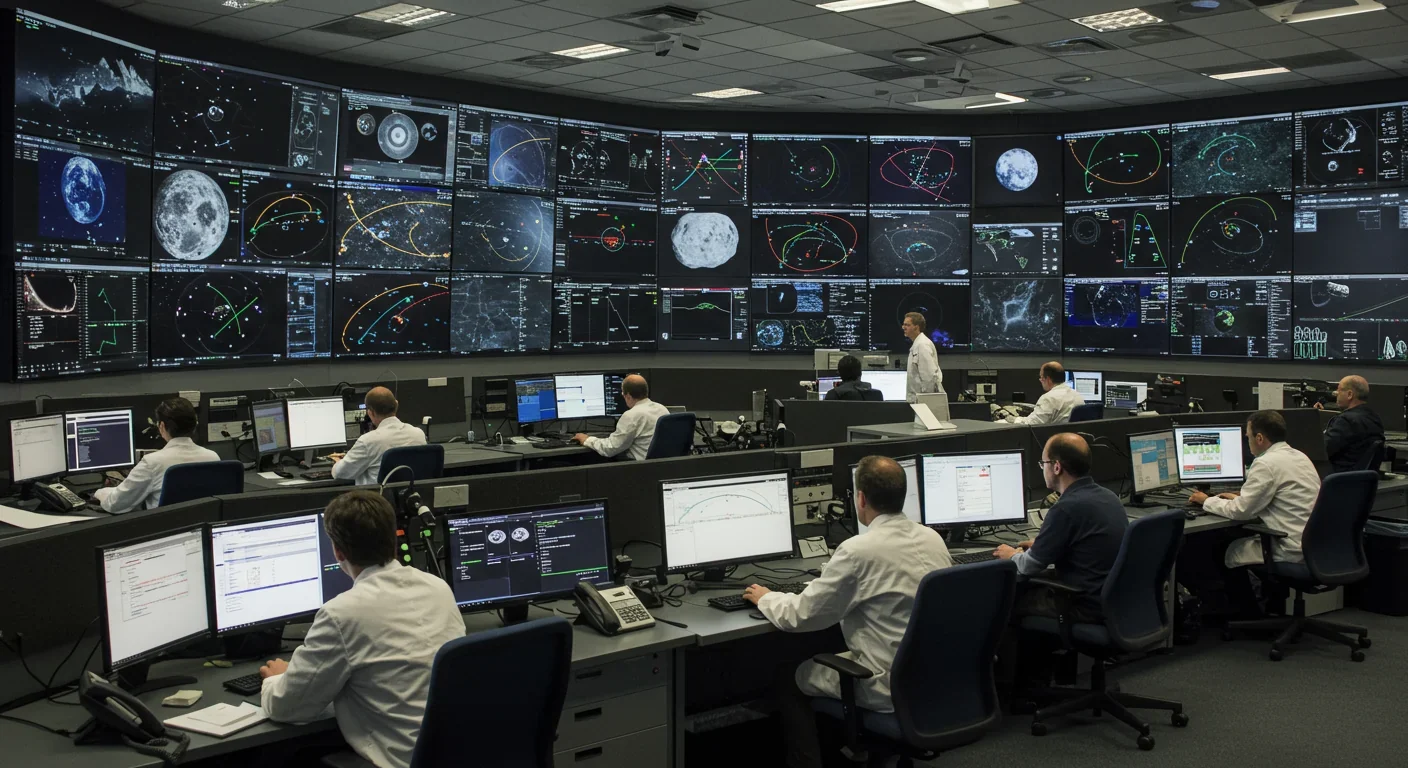The Gravity Heresy: MOND vs Dark Matter Theory Explained

TL;DR: Humanity is building a global network of telescopes, radar systems, and space missions to detect and deflect dangerous asteroids before they strike Earth, with proven technologies like NASA's DART mission showing we can successfully alter an asteroid's course.

By the end of this decade, your chances of being warned about an incoming asteroid will jump from slim to nearly certain. Not because the rocks are changing course, but because we're finally getting serious about watching the skies.
On September 26, 2022, NASA deliberately crashed a spacecraft into an asteroid called Dimorphos, moving it off course by 32 minutes. It wasn't science fiction anymore. It was a dress rehearsal for saving the world.
On February 15, 2013, a 17-meter meteor exploded over Chelyabinsk, Russia, injuring over 1,500 people and shattering windows across the region. The scary part? Nobody saw it coming. The sky just lit up. That's when governments around the world realized asteroid detection wasn't a luxury, it was a necessity.
For decades, astronomers had been cataloging near-Earth objects on shoestring budgets. The Catalina Sky Survey in Arizona was running automated telescopes to spot asteroids, but it was like trying to guard an entire city with one security camera. The coverage was patchy, the funding inconsistent, and the public mostly indifferent.
Then Chelyabinsk happened. Suddenly, planetary defense went from fringe science to national priority.
Today, we track more than 35,000 near-Earth objects, but scientists estimate there are at least a million space rocks out there bigger than 30 meters. Most of them? Still invisible to us. And a 30-meter rock can level a city.
That's why the race is on to build what amounts to a cosmic early warning system, a global network of telescopes, radars, and space missions designed to spot threats years before they arrive.
The core challenge is simple: asteroids are dark, fast, and small relative to the vastness of space. Spotting one is like trying to see a lump of coal flying past a distant streetlight at thousands of miles per hour.
Ground-based telescopes do the heavy lifting. The Asteroid Terrestrial-impact Last Alert System (ATLAS), operated by the University of Hawaii, scans the entire visible sky every night using four 0.5-meter telescopes spread across the globe. Each telescope cycles through the sky with 30-second exposures, completing a full sweep every clear night. ATLAS can provide a one-week warning for a 45-meter asteroid and up to three weeks for a 120-meter one, assuming the object isn't too close to the Sun.
That's not much time to evacuate a city, but it's infinitely better than zero.
Space-based detection changes the game. Infrared telescopes like NEOWISE detect the heat signature of asteroids rather than relying on reflected sunlight. This is crucial because many asteroids are extremely dark, absorbing most visible light. NEOWISE has discovered hundreds of near-Earth objects since its launch in 2009, proving that space-based infrared surveys can see what ground telescopes miss.
The upcoming NEO Surveyor mission, scheduled for launch in the late 2020s, will take this further. Positioned at the Sun-Earth L1 point (a gravitational sweet spot between the two bodies), it will scan the sky continuously with a 50-centimeter infrared telescope operating in two thermal bands. NEO Surveyor is designed to discover 200,000 to 300,000 new near-Earth objects as small as 10 meters in diameter over its 12-year mission.

Radar astronomy provides precision tracking once an asteroid is detected. Facilities like the Arecibo Observatory (before its collapse in 2020) and the Goldstone Deep Space Communications Complex bounce radio waves off asteroids, measuring their size, shape, rotation, and orbit with incredible accuracy. Radar can pin down an asteroid's trajectory years into the future, turning a fuzzy detection into a precise threat assessment.
But detection is only half the battle. The real question is: what do we do once we find one heading our way?
If you're imagining Bruce Willis planting nuclear bombs inside an asteroid, you're not far off from one of the actual options on the table. But the reality is more nuanced, and in most cases, more elegant.
The kinetic impactor is the method we've actually tested. NASA's DART mission proved it works. The concept is brutally simple: slam a spacecraft into an asteroid at high speed and let momentum do the rest. DART hit Dimorphos at roughly 14,000 miles per hour, and the collision did more than just transfer momentum. The impact ejected tons of rock and debris, creating a jet-like thrust that pushed the asteroid even further off course. The ejecta multiplied the deflection effect by acting like a rocket engine in reverse.
The result? Dimorphos's orbital period around its companion asteroid Didymos shortened by 32 minutes, far exceeding NASA's minimum success threshold of 73 seconds. This wasn't a nudge. It was a shove.
The beauty of a kinetic impactor is its simplicity. You don't need exotic technology, just a well-aimed spacecraft traveling fast enough to pack a punch. The downside is timing. You need years of advance warning because a small nudge early in an asteroid's orbit translates to a massive miss later on. Wait too long, and the impactor won't deflect it enough.
The gravity tractor is the gentler option. Instead of crashing into the asteroid, a spacecraft would hover nearby for months or years, using its own gravitational pull to slowly tug the asteroid off course. It sounds absurd, that a spacecraft weighing a few tons could pull an asteroid weighing millions of tons, but gravity doesn't care about mass ratios. Given enough time, even a tiny gravitational attraction can shift an orbit.
A 2006 study funded by the B612 Foundation and conducted by NASA's Jet Propulsion Laboratory confirmed that a gravity tractor could deflect a 200-meter asteroid with 20 years of advance warning. The challenge is power. Keeping a spacecraft hovering in a precise position for years requires substantial fuel and propulsion, likely ion thrusters running on solar or nuclear power.
Then there's the nuclear option. Not exploding the asteroid (that would just turn one threat into many), but detonating a warhead nearby to vaporize part of its surface. The expanding gas would create thrust, pushing the asteroid away. Recent lab tests using X-ray pulses on asteroid-like materials suggest this method could work, especially for large, solid objects that resist fragmentation.
Nuclear deflection has one major advantage: it works fast. If we only have months of warning, a kinetic impactor or gravity tractor won't cut it. A nuclear standoff burst could deliver enough energy to alter the trajectory of even a massive asteroid on short notice. The political and technical hurdles are enormous, requiring international agreements and precise detonation timing, but it's the only option we have for worst-case scenarios.
No single country can protect Earth alone. Asteroids don't respect borders, and the infrastructure needed to detect and deflect them is expensive and complex. That's why planetary defense is becoming one of the rare areas of genuine international cooperation.
NASA's Planetary Defense Coordination Office, established in 2016, coordinates detection efforts, models impact risks, and leads deflection missions like DART. But NASA doesn't work in isolation. The European Space Agency's Hera mission, set to visit Dimorphos in 2027, will study the aftermath of the DART impact in detail, measuring the crater size, ejecta distribution, and internal structure of the asteroid. This data is essential for refining our deflection models.
Japan's space agency, JAXA, has pioneered asteroid sample-return missions with Hayabusa and Hayabusa2, demonstrating the precision navigation and landing techniques that could be adapted for defense missions. China is developing its own near-Earth object survey capabilities and has expressed interest in collaborating on planetary defense.

The United Nations established the International Asteroid Warning Network (IAWN) and the Space Mission Planning Advisory Group (SMPAG) to facilitate global coordination. IAWN shares detection data among observatories worldwide, while SMPAG coordinates response planning in the event of a confirmed threat.
This network isn't just symbolic. When an asteroid is detected, observatories around the world immediately begin tracking it to refine its orbit. The Minor Planet Center, operated by the Smithsonian Astrophysical Observatory, serves as the clearinghouse for all asteroid observations, collecting data from hundreds of telescopes and calculating precise orbits.
The Torino Scale, developed by MIT planetary scientist Richard Binzel, provides a standardized way to communicate asteroid threat levels to the public. It runs from 0 (no hazard) to 10 (certain collision with global consequences), giving governments and media a common language for discussing risk without causing panic.
Not every asteroid detection turns into a headline. In fact, most don't. The vast majority of near-Earth objects pass harmlessly by, and the ones that do enter Earth's atmosphere usually burn up or explode harmlessly over uninhabited areas.
Asteroid 99942 Apophis caused a brief panic in 2004 when initial calculations suggested a 2.7% chance of impact in 2029. That may not sound high, but for a 370-meter asteroid capable of regional devastation, it was terrifying. Further observations refined its orbit and ruled out the 2029 impact, but for a while, Apophis held a Torino Scale rating of 4, the highest ever assigned to an asteroid.
Apophis will still pass close to Earth in 2029, close enough that it will be visible to the naked eye in some regions and will pass within the orbit of some satellites. Scientists will use this rare flyby as an opportunity to study the asteroid up close, testing detection and tracking systems in a real-world scenario.
Then there's 2024 YR4, a 53-to-67-meter asteroid discovered by ATLAS. While not currently on a collision course, its orbit brings it close enough that scientists are discussing potential reconnaissance and mitigation missions as a test case for future defense scenarios.
The challenge with asteroid risk communication is balancing transparency with avoiding panic. Most newly discovered asteroids have uncertain orbits because we haven't observed them long enough. Probability calculations improve rapidly with more observations, often dropping from "possible threat" to "no risk" within days. But headlines tend to focus on the initial uncertainty, creating the impression that asteroid threats are more common than they are.
The next decade will see planetary defense mature from proof-of-concept to operational capability. NEO Surveyor will dramatically expand our catalog of near-Earth objects, aiming to find 90% of all asteroids larger than 140 meters, the size capable of causing regional devastation. This ambitious goal requires not just better telescopes, but improved data processing algorithms to sift through the millions of observations and identify the ones that matter.
Machine learning is already transforming asteroid detection. New methods can distinguish asteroids from background stars and cosmic rays with far greater accuracy than traditional algorithms, reducing false positives and speeding up orbit calculations. These techniques will be essential for processing the flood of data from next-generation surveys.
ESA's Hera mission will provide crucial data on how asteroids respond to impacts, informing the design of future deflection missions. Hera will carry two small cubesats that will study Dimorphos from multiple angles, measuring its internal structure and composition. This information is critical because asteroids aren't uniform. Some are solid rock, others are loose rubble piles held together by gravity, and their response to a kinetic impact varies wildly.
The longer-term vision includes more ambitious technologies. Laser ablation, which would use concentrated sunlight or laser beams to vaporize part of an asteroid's surface and create thrust, is being studied as a potential deflection method for smaller objects. Solar sails and ion beam deflectors are also on the drawing board, though they remain decades from practical deployment.
Funding remains the persistent challenge. The 2005 George E. Brown Jr. Near-Earth Object Survey Act directed NASA to find 90% of near-Earth objects larger than 140 meters by 2020, but Congress never appropriated the money to actually do it. NEO Surveyor, originally planned for launch in 2025, was delayed multiple times due to budget constraints and is now targeting the late 2020s. The mission's total cost is estimated at around $1.2 billion over its lifetime, a rounding error in most national budgets but a significant chunk of NASA's planetary science funding.
Planetary defense might seem like the exclusive domain of space agencies and astronomers, but public engagement matters. Amateur astronomers contribute observations to the Minor Planet Center, helping to refine asteroid orbits. Citizen science projects process telescope data, looking for objects that automated systems miss.
Staying informed helps too. Understanding the real risks and the actual capabilities of our defense systems prevents both complacency and panic. The truth is, we're far better prepared than we were a decade ago, but we're not invulnerable. The asteroids that pose the greatest near-term risk are the ones we haven't found yet, the city-killers lurking in the glare of the Sun or on trajectories that bring them into view only weeks before impact.
Supporting funding for planetary defense initiatives, whether through contacting representatives or simply recognizing the importance of this work, helps ensure the infrastructure stays in place. Unlike many threats, asteroid impacts are preventable, but only if we invest in the systems that give us warning and the tools to respond.
The cosmic shield we're building isn't flashy. There are no lasers in space (yet) or astronauts training to blow up asteroids. It's mostly telescopes, computers, and careful planning. But it's real, it's growing, and for the first time in human history, we have a genuine chance to see a killer asteroid coming and do something about it.
That's not science fiction. That's just good engineering and a willingness to take the long view. Because the question isn't if another asteroid will head our way. It's when, and whether we'll be ready.

MOND proposes gravity changes at low accelerations, explaining galaxy rotation without dark matter. While it predicts thousands of galaxies correctly, it struggles with clusters and cosmology, keeping the dark matter debate alive.

Ultrafine pollution particles smaller than 100 nanometers can bypass the blood-brain barrier through the olfactory nerve and bloodstream, depositing in brain tissue where they trigger neuroinflammation linked to dementia and neurological disorders, yet remain completely unregulated by current air quality standards.

CAES stores excess renewable energy by compressing air in underground caverns, then releases it through turbines during peak demand. New advanced adiabatic systems achieve 70%+ efficiency, making this decades-old technology suddenly competitive for long-duration grid storage.

Our brains are hardwired to see patterns in randomness, causing the gambler's fallacy—the mistaken belief that past random events influence future probabilities. This cognitive bias costs people millions in casinos, investments, and daily decisions.

Forests operate as synchronized living systems with molecular clocks that coordinate metabolism from individual cells to entire ecosystems, creating rhythmic patterns that affect global carbon cycles and climate feedback loops.

Generation Z is the first cohort to come of age amid a polycrisis - interconnected global failures spanning climate, economy, democracy, and health. This cascading reality is fundamentally reshaping how young people think, plan their lives, and organize for change.

Zero-trust security eliminates implicit network trust by requiring continuous verification of every access request. Organizations are rapidly adopting this architecture to address cloud computing, remote work, and sophisticated threats that rendered perimeter defenses obsolete.